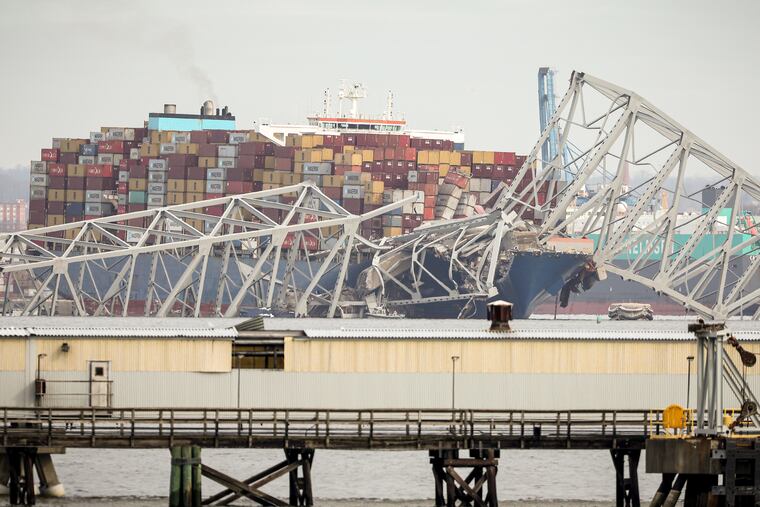How the Baltimore bridge collapse could affect Philadelphia’s port and your commute
While the impact on Philadelphia remains to be seen, here’s what we know so far.

A cargo ship lost power and ran into a bridge in Baltimore early Tuesday, causing the span to collapse into a river and prompting a search for survivors.
Officials said they were searching for at least six people who were on the Francis Scott Key Bridge when it was struck by the ship Tuesday morning. Two people were pulled from the water and one remains in the hospital, according to Maryland Transportation Secretary Paul Wiedefeld.
The bridge collapse shut down ship traffic in the Port of Baltimore, a big commercial hub, threatening supply chain disruptions.
While the impact on Philadelphia remains to be seen, here’s what we know about how the collapse may impact the Port of Philadelphia and the lives of area commuters.
No ‘significant traffic challenges’ in Pa. expected
The Pennsylvania Department of Transportation does not anticipate “significant traffic challenges” in the state, an agency spokesperson said.
But ... Baltimore’s ‘death-grip congestion’ might cause a few delays
The collapse of the Francis Scott Key Bridge could complicate personal travel and trucking in the Philadelphia region and beyond because of Baltimore’s central location on I-95, the East Coast’s major traffic corridor.
Just two tunnels remain for interstate traffic through Baltimore and its moatlike harbor to the Chesapeake Bay and south, said Chenfeng Xiong, an assistant engineering professor at Villanova University specializing in transportation. ”They’ll be swamped,” Xiong said, speaking of the Fort McHenry Tunnel, which carries I-95 traffic, and the Baltimore Harbor Tunnel, which carries I-895 traffic. They can be clogged even in normal conditions.
”There’s going to be death-grip congestion there,” he said, delaying travel to and from Philadelphia, increasing costs for the trucks that supply the region and service its massive warehouses.
The effective blockade of the land entrance to Baltimore’s port could lead to “delays in cargo and shipping cost increases,” said Xiong, who uses big data to analyze traffic patterns and transportation economics. He has conducted research for the Maryland Department of Transportation.
Alternative routes if you’re traveling from Philly to Baltimore
Here is what Philadelphia-area travelers heading to or around Baltimore need to know about detours:
I-695, a beltway that encircles Baltimore and its near suburbs, is not available for crossing Baltimore Harbor because of the collapse of the bridge.
Maryland authorities advise that motorists can cross the harbor via the Fort McHenry Tunnel, which carries I-95 traffic, and the Baltimore Harbor Tunnel, which carries I-895 traffic under the Patapsco River a few miles above the closed bridge.
Traffic on the outer loop of I-695 is being detoured at Maryland Route 10 at Exit 2. The detour for inner-loop traffic is at Exit 43 for MD 157.
Philly port ready to assist, if needed
The head of the logistics company that operates the Port of Philadelphia’s biggest terminal said Tuesday that he expects the container ship accident in Baltimore to have an impact on supply chains but expressed confidence that East Coast ports would be able to handle additional cargo.
Vessel traffic into and out of Baltimore was suspended after the bridge collapse.
“The supply chain will be taxed, we believe, in the weeks and months to come, but no more so than what we experienced in recent years and have demonstrated in terms of the North Atlantic ports as having an absolute resilience to challenges,” said Leo Holt, president of Holt Logistics, which operates the Packer Avenue Marine Terminal in South Philadelphia.
Holt said he and the “entire port community” were “heartbroken by the events in Baltimore.” Eight construction workers were on the bridge when it collapsed, officials said, and the search for survivors was ongoing.
Port authorities, ocean shipping carriers, and cargo owners will work together to find a home for cargo diverted from Baltimore until that port is back up and running, he said. It’s unclear how long that will take.
“This is not Philadelphia vs. Baltimore,” Holt said. “ … This is ports in the North Atlantic reaching out to support Baltimore.”
A major trade hub, Baltimore’s port handled almost 850,000 autos and light trucks in 2023, the most of any port in the country, according to Maryland state data. Other imports include sugar and coffee.
Baltimore-bound cargo ships are likely to be diverted to bigger container ports in New York, New Jersey, and Virginia, the Wall Street Journal reported. The Port of Philadelphia has almost doubled container volume in the last eight years, but remains a smaller player in container shipping.
Ryan Mulvey, director of government and public affairs for the Philadelphia Regional Port Authority (PhilaPort), said the state agency “stands ready to support the Port of Baltimore.”
“The port community is relatively small. We all know each other. We try to support each other. If there are diversions, if ships need places to go, we stand at the ready for that to ensure the supply chain remains intact,” he said. “Right now I don’t think anyone’s thoughts are on how cargo is going to land. It’s more so on rescuing and supporting rescue workers on the scene.”
Staff writer Rob Tornoe contributed to this article.